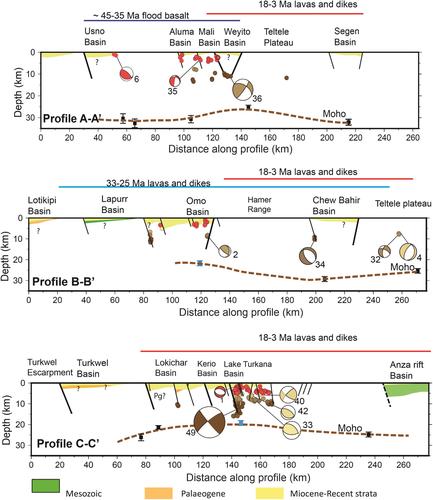当前位置:
X-MOL 学术
›
Basin Res.
›
论文详情
Our official English website, www.x-mol.net, welcomes your
feedback! (Note: you will need to create a separate account there.)
Kinematics of rift linkage between the Eastern and Ethiopian rifts in the Turkana Depression, Africa
Basin Research ( IF 2.8 ) Pub Date : 2024-09-14 , DOI: 10.1111/bre.12900 Garrett Sullivan 1 , C. J. Ebinger 1 , M. Musila 1 , Mason Perry 2 , E. R. Kraus 1 , Ian Bastow 3 , Becks Bendick 4
Basin Research ( IF 2.8 ) Pub Date : 2024-09-14 , DOI: 10.1111/bre.12900 Garrett Sullivan 1 , C. J. Ebinger 1 , M. Musila 1 , Mason Perry 2 , E. R. Kraus 1 , Ian Bastow 3 , Becks Bendick 4
Affiliation

|
Rift initiation within cold, thick, strong lithosphere and the evolving linkage to form a contiguous plate boundary remains debated in part owing to the lack of time–space constraints on kinematics of basement‐involved faults. Different rift sectors initiate diachronously and may eventually link to produce a jigsaw spatial pattern, as in the East African rift, and along the Atlantic Ocean margins. The space–time distribution of earthquakes illuminates the geometry and kinematics of fault zones within the crystalline crust, as well as areas with pressurized magma bodies. We use seismicity and Global Navigation System Satellites (GNSS) data from the Turkana Rift Array Investigating Lithospheric Structure (TRAILS) project in East Africa and a new digital compilation of faults and eruptive centres to evaluate models for the kinematic linkage of two initially separate rift sectors: the Main Ethiopian Rift (MER) and the Eastern rift (ER). The ca. 300 km wide zone of linkage includes failed basins and linkage zones; seismicity outlines active structures. Models of GNSS data indicate that the ca. 250 km‐wide zone of seismically active en echelon basins north of the Turkana Depression is a zone, or block, of distributed strain with small counterclockwise rotation that serves to connect the Main Ethiopian and Eastern rifts. Its western boundary is poorly defined owing to data gaps in South Sudan. Strain across the northern and southern boundaries of this block, and an ca. 50 km‐wide kink in the southern Turkana rift is accommodated by en echelon normal faults linked by short strike‐slip faults in crystalline basement, and relay ramps at the surface. Short segments of obliquely oriented basement structures facilitate across‐rift linkage of faults, but basement shear zones and Mesozoic rift faults are not actively straining. This configuration has existed for at least 2–5 My without the development of localized shear zones or transform faults, documenting the importance of distributed deformation in continental rift tectonics.
中文翻译:

非洲图尔卡纳凹陷东部和埃塞俄比亚裂谷之间裂谷联系的运动学
冷、厚、坚固的岩石圈内裂谷的萌生以及形成连续板块边界的演化联系仍然存在争议,部分原因是对基底相关断层的运动学缺乏时空限制。不同的裂谷部分历时地开始,并最终可能连接起来产生拼图空间模式,如东非裂谷和大西洋边缘。地震的时空分布揭示了结晶地壳内断层带以及加压岩浆体区域的几何形状和运动学。我们使用东非图尔卡纳裂谷阵列调查岩石圈结构 (TRAILS) 项目的地震活动性和全球导航系统卫星 (GNSS) 数据以及断层和喷发中心的新数字汇编来评估两个最初独立的裂谷部分的运动学联系模型:埃塞俄比亚主要裂谷(MER)和东部裂谷(ER)。约。 300公里宽的联系区包括失陷盆地和联系区;地震活动勾画出活动结构。 GNSS 数据模型表明,大约。图尔卡纳凹陷以北 250 公里宽的地震活动梯队盆地区域是一个具有小幅逆时针旋转的分布应变区域或区块,用于连接埃塞俄比亚主要裂谷和东部裂谷。由于南苏丹的数据差距,其西部边界界定不明确。穿过该街区的北部和南部边界,大约。图尔卡纳裂谷南部 50 公里宽的扭结由结晶基底中的短走滑断层和地表中继坡道连接的梯队正断层容纳。 倾斜定向的基底结构的短段有利于断层的跨裂谷联系,但基底剪切带和中生代裂谷断层并不活跃应变。这种构造已经存在了至少 2-5 My,没有形成局部剪切带或转换断层,这证明了大陆裂谷构造中分布变形的重要性。
更新日期:2024-09-14
中文翻译:

非洲图尔卡纳凹陷东部和埃塞俄比亚裂谷之间裂谷联系的运动学
冷、厚、坚固的岩石圈内裂谷的萌生以及形成连续板块边界的演化联系仍然存在争议,部分原因是对基底相关断层的运动学缺乏时空限制。不同的裂谷部分历时地开始,并最终可能连接起来产生拼图空间模式,如东非裂谷和大西洋边缘。地震的时空分布揭示了结晶地壳内断层带以及加压岩浆体区域的几何形状和运动学。我们使用东非图尔卡纳裂谷阵列调查岩石圈结构 (TRAILS) 项目的地震活动性和全球导航系统卫星 (GNSS) 数据以及断层和喷发中心的新数字汇编来评估两个最初独立的裂谷部分的运动学联系模型:埃塞俄比亚主要裂谷(MER)和东部裂谷(ER)。约。 300公里宽的联系区包括失陷盆地和联系区;地震活动勾画出活动结构。 GNSS 数据模型表明,大约。图尔卡纳凹陷以北 250 公里宽的地震活动梯队盆地区域是一个具有小幅逆时针旋转的分布应变区域或区块,用于连接埃塞俄比亚主要裂谷和东部裂谷。由于南苏丹的数据差距,其西部边界界定不明确。穿过该街区的北部和南部边界,大约。图尔卡纳裂谷南部 50 公里宽的扭结由结晶基底中的短走滑断层和地表中继坡道连接的梯队正断层容纳。 倾斜定向的基底结构的短段有利于断层的跨裂谷联系,但基底剪切带和中生代裂谷断层并不活跃应变。这种构造已经存在了至少 2-5 My,没有形成局部剪切带或转换断层,这证明了大陆裂谷构造中分布变形的重要性。






























 京公网安备 11010802027423号
京公网安备 11010802027423号